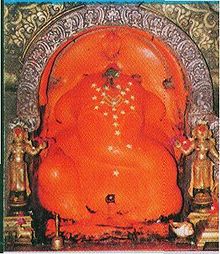 Shri Mayureshwar Mandir or Shri Moreshwar Mandir is a Hindu temple (mandir) dedicated to Ganesha, the elephant-headed god of wisdom. It is located in Morgaon in Pune District, about 80 kilometres (50 mi) away from Pune city in the Indian state of Maharashtra. The temple is the starting and ending point of a pilgrimage of eight revered Ganesha temples called Ashtavinayaka.
Shri Mayureshwar Mandir or Shri Moreshwar Mandir is a Hindu temple (mandir) dedicated to Ganesha, the elephant-headed god of wisdom. It is located in Morgaon in Pune District, about 80 kilometres (50 mi) away from Pune city in the Indian state of Maharashtra. The temple is the starting and ending point of a pilgrimage of eight revered Ganesha temples called Ashtavinayaka.
Legends
According to the Ganesha Purana, Ganesha incarnated as Mayuresvara or Mayureshwar (Mayūreśvara), who has six arms and a white complexion. His mount is a peacock. He was born to Shiva and Parvati in the Treta yuga, for the purpose of killing the demon Sindhu.
Sindhu was the son of Cakrapani – the king of Mithila and his wife Ugrā. Ugrā conceived due to the power of a solar mantra, but was unable to bear the extreme heat radiating from the foetus, so she abandoned it in the ocean. Soon, a son was born from this abandoned foetus and the ocean returned him to his grieving father, who named him Sindhu – the ocean.
Parvati underwent austerities meditating on Ganesha – "the supporter of the entire universe" – for twelve years at Lenyadri (another Ashtavinayak site, where Ganesha is worshiped as the son of Parvati). Pleased by her penance, Ganesha blessed her by the boon that he would be born as her son. In due course, Ganesha was born to Parvati at Lenyadri and named as Gunesha by Shiva. Little Gunesha once knocked an egg from a mango tree, from which emerged a peacock. Gunesha mounted the peacock and assumed the name Mayuresvara.
Sindhu was given the ever-full bowl of amrita (elixir of life) as a boon from the Sun-god. The demon was warned that he could drink from the bowl as long as it was intact. So to protect the bowl, he swallowed it. Sindhu terrorized the three worlds, so the gods asked Gunesha for help. Gunesha defeated Sindhu's army, cut his general Kamalasura into three pieces and then cut open Sindhu's body, emptying the amrita bowl and thus killing the demon. The creator-god Brahma is described as having built the Morgaon shrine, and marrying Siddhi and Buddhi to Ganesha. At the end of this incarnation, Gunesha returned to his celestial abode, giving his peacock mount to his younger brother Skanda, with whom the peacock mount is generally associated.
Because Ganesha rode a peacock (in Sanskrit, a mayura, in Marathi – mora), he is known as Mayureshwar or Moreshwar ("Lord of the peacock"). Another legend says that this place was populated by peacocks giving the village its Marathi name, Morgaon ("Village of peacocks"), and its presiding deity the name Moreshwar.
A Ganapatya legend recalls how the creator-god Brahma, the preserver-god Vishnu and the dissolver-god Shiva, the Divine Mother Devi and the Sun-god Surya mediated at Morgaon to learn about their creator and their purpose of existence. Ganesha emerged before them in form of an Omkara flame and blessed them. Another legend records that when Brahma created his son Kama (desire), he became a victim of desire and lusted for his own daughter Sarasvati (Goddess of learning). Upon invocation by all of the deities, the sacred Turiya Tirtha river appeared and Brahma bathed in her waters to cleanse his sin of incest. Brahma then came to Morgaon to worship Ganesha, carrying water from the river in his water pot. Entering the Ganesha shrine, Brahma stumbled and water fell from the pot. When Brahma tried to pick it up, it was turned into the sacred Karha river, that still flows at Morgaon.
Places of Interest
As part of the Ashta Vinayak pilgrimage one can embark on a journey to all eight shrines, which fall within a 200 mile radius. Other places of interest are Sangameshwar and Changawateshwar.
Accommodation
Pune, a two-hour drive from the village is a bustling metropolis and offers world-class accommodative facilities in addition to many budget options.